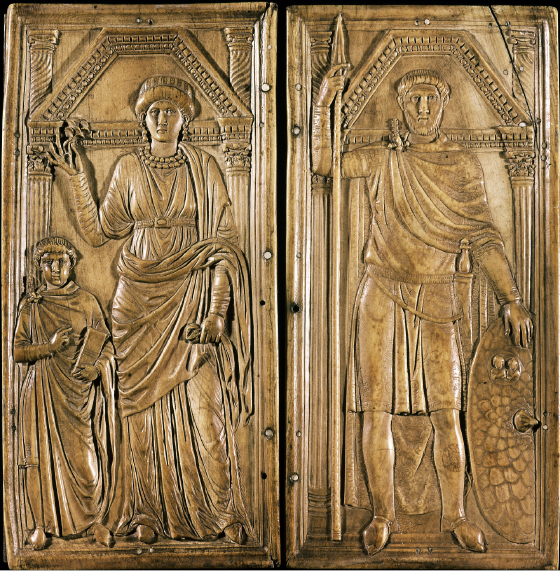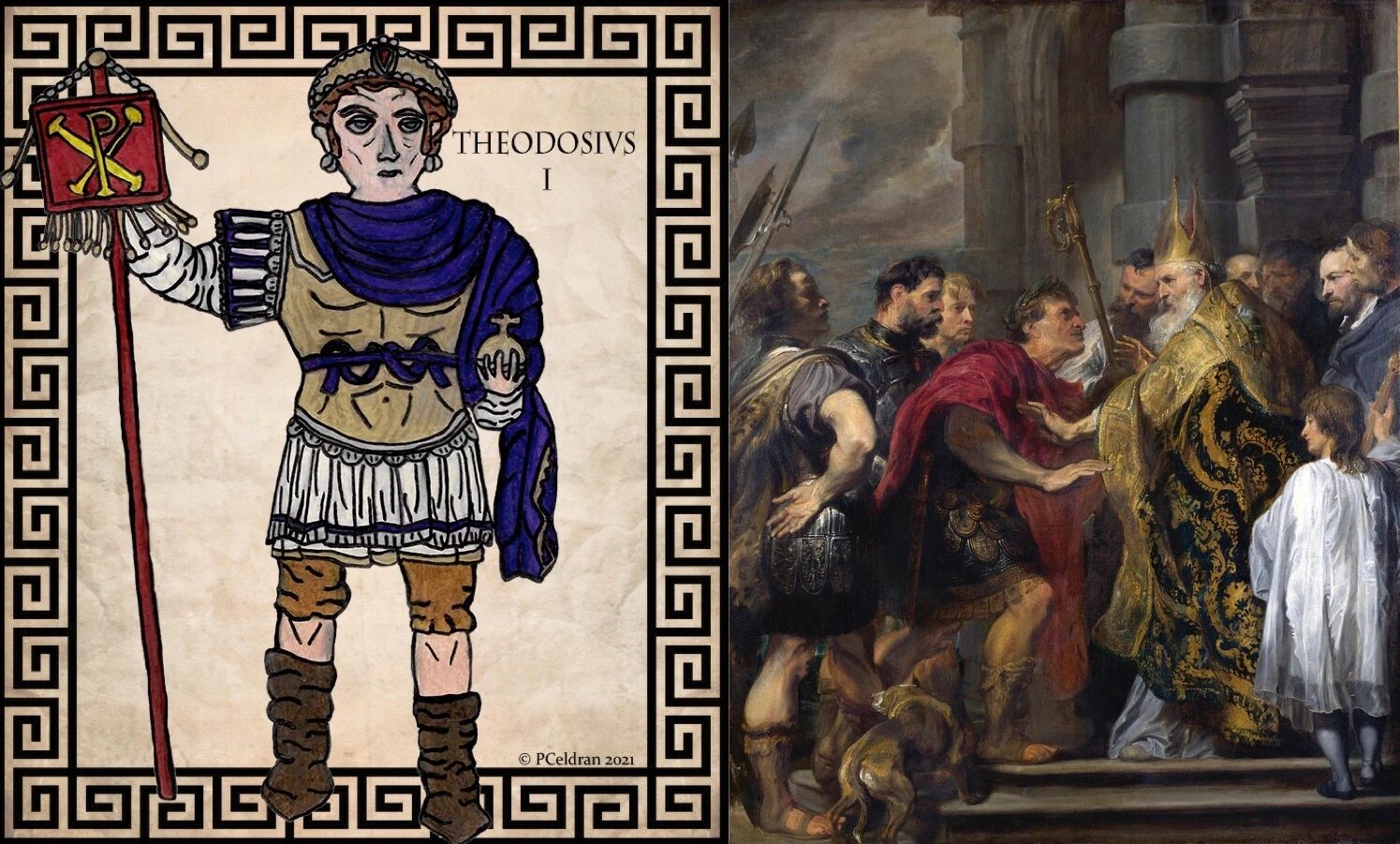In the late summer of 394, Emperor Theodosius embarked on a critical journey through the Julian Alps alongside 50,000 soldiers, confronted by the looming threat of civil war. Tensions had escalated following the death of Valentinian II, the Western Roman Emperor, whose demise was mired in mystery and suspicion. The power struggle that ensued saw Theodosius poised to reclaim the unified Roman Empire from the grasp of the Western usurpers.
Accompanying Theodosius was his trusted general Stilicho, a man of both Roman and Vandal heritage, whose leadership was instrumental in the unfolding events. Theodosius’s campaign culminated in a decisive battle against the forces led by the Western General Arbogast. Following Theodosius’s victory, an era of political intrigue began, filled with challenges that shaped the future of the Roman Empire and revealed the complexities of leadership in both the Eastern and Western territories.
Key Takeaways
- Emperor Theodosius aimed to reunite the Roman Empire.
- Stilicho faced political and military challenges in the West.
- Alaric’s actions posed significant threats to Roman stability.
Emperor Theodosius’s Journey
Bringing the Roman Empire Together
In 394, Emperor Theodosius moved decisively to restore unity to a divided Roman Empire. Western ruler, Valentinian II, had attempted to remove his powerful general, Arbogast. Arbogast refused and tore the emperor’s orders, claiming they were invalid. Soon after, Valentinian II was discovered dead, hanging in suspicious circumstances. Arbogast asserted that it was suicide, but suspicions of foul play remained. With Valentinian’s death, Theodosius asserted his claim over the entire Roman Empire, challenging Arbogast’s grip on power.
Arbogast’s Rebellion and Eugenius’s Rise
Arbogast refused to accept Theodosius’s authority and placed his own candidate, Eugenius, as the Western ruler. This set the stage for conflict. Theodosius, accompanied by his capable general Stilicho, marched to Italy, determined to reclaim the empire. Stilicho, of part-Vandal origin, proved a loyal ally. Standing with Theodosius were 20,000 federated troops, including Goths led by Alaric, who had been pressed into Roman service.
In a fierce confrontation, Arbogast’s forces initially achieved a significant victory. Yet, the following day, Theodosius and Stilicho launched a counter-attack aided by strong winds that disrupted their opponents. This change in fortune allowed them to break through Arbogast’s defenses. Eugenius was executed, and Arbogast fled, eventually taking his own life. Theodosius had successfully unified the empire, planning for his sons to rule its eastern and western halves in the future.
Valentinian II’s Mysterious End and the Resulting Consequences
Valentinian II tried to strip power from General Arbogast, who had become overpowering. Arbogast rejected this attempt and even tore up the emperor’s order in defiance. Shortly after, Valentinian was found dead, hanging in his residence. Arbogast claimed it was a suicide, but doubt lingered, and many suspected foul play.
With Valentinian’s demise, Theodosius, the Eastern Emperor, emerged as the legitimate ruler of a once again whole Roman Empire. Arbogast, however, refused to accept Theodosius’ authority, installing Eugenius as a puppet ruler in the West. This set the stage for a civil war, prompting Theodosius to move against Arbogast to reunite the empire under his rule. Marching towards Italy with his loyal general Stilicho, Theodosius confronted the forces of Arbogast in a decisive battle.
The following events unfolded swiftly. After Theodosius’ victory, the empire seemed united, but the intricacies of political guardianship over Theodosius’ young sons arose. Stilicho was entrusted with protecting the young Honorius until he was old enough to rule, although his claim over Arcadius, ruling in the East, faced skepticism. Arcadius remained under the influence of Rufinus, weakening Stilicho’s reach.
The empire was torn once more, with tensions brewing over military command and a divided rule. Stilicho struggled with the challenges of holding forces together and confronting new threats from leaders like Alaric, whose actions continued to destabilize the region. While Stilicho aimed to stabilize and reunify the empire, internal and external pressures loomed ever larger.
Theodosius’s Campaign against Eugenius

Stilicho, The Vandal General
Stilicho, a skilled military leader with roots in the Vandal tribe, played a crucial role as Theodosius’s trusted general. Despite his mixed heritage, which may have been looked down upon by Roman aristocrats, Theodosius saw Stilicho’s value and trusted him deeply. Stilicho held the position of leading the emperor’s elite guard as they made their way through the Julian Alps. His connection to Theodosius was strengthened through marriage to his adopted daughter, Serena, allowing him to climb the ranks within the Roman Empire.
Federated Troops and the Battle’s Beginning
The Eastern Roman army was bolstered by about 20,000 federated troops, including barbarians and Goths. One key figure among these allied forces was Alaric, a Gothic leader who had reluctantly pledged his service to Rome after previous conflicts. As the armies moved from the mountain paths, they encountered Arbogast’s larger Western army. In anticipation of regaining control, Theodosius commanded a frontal assault. The battle initially turned against them, with significant losses, and the Western army felt victorious.
Arbogast’s Defeat and Theodosius’s Victory
The following day, Theodosius and Stilicho led a renewed effort against Arbogast’s forces. A sudden gust of wind blew dust into the Western forces’ eyes, severely impairing their archer’s effectiveness. This unforeseen advantage allowed the Eastern army to break through Arbogast’s lines and capture his camp. With Eugenius executed and Arbogast fleeing into the mountains, a brief pursuit ended in Arbogast’s death. Consequently, Theodosius’s victory restored unity to the Roman Empire under his leadership.
Theodosius’s Illness and Passing
Succession and Stilicho’s Guardian Role
Emperor Theodosius passed away during a harsh winter, leaving a leadership gap in the Empire. He entrusted Stilicho, a seasoned military leader, with the guardianship of his younger son, Honorius. At just 10 years old, Honorius was too young to rule. This decision effectively made Stilicho the ruler of the Western Roman Empire until Honorius could take full control.
Theodosius’s elder son, Arcadius, was set to rule the East. While he nominally held power, his youth and inexperience left him vulnerable to manipulation by more experienced politicians and generals.
Stilicho’s Claim to Authority over Both Empires
Stilicho asserted that before his death, Theodosius had granted him a kind of guardianship over Arcadius as well. This claim was contentious and not without opposition. Arcadius, under the influence of the Eastern general Rufinus, rejected Stilicho’s assertion, creating a tension between East and West.
To Stilicho, the struggle for control seemed like an issue to be addressed later. His immediate focus was on stabilizing his control over the West and managing the considerable military forces inherited from Theodosius. This division further complicated the already strained relationship between the two halves of the Roman Empire.
Stilicho’s Rule and Challenges
Disbanding the Federates and Alaric’s Reaction
Stilicho faced a difficult situation after Theodosius’s death. He suddenly had control over an enormous military force, comprising both the Eastern and Western Roman armies. To manage this vast army, Stilicho deemed it necessary to release some of the federates, notably those led by the Gothic leader, Alaric.
Without any recognition or reward, Alaric and his forces were dismissed, leading to an upset. Alaric’s response to this dismissal was swift and destructive. His forces began to raid the Roman provinces, advancing toward Constantinople, the Eastern capital. In a bid to pacify Alaric, Rufinus, the Eastern general, allowed him to invade the Balkans and Greece. This decision led to further unrest and invited destructive raids on the cities in these regions.
Rivalry with Eastern General Rufinus
Stilicho’s aspiration to maintain influence over both the Western and Eastern portions of the Roman Empire was a thorny task due to Rufinus, a formidable opponent in the East. Rufinus wielded significant power as he controlled Arcadius’s decisions and resisted Stilicho’s claim of guardianship over him.
This rivalry escalated when Stilicho attempted to pursue and neutralize Alaric in the Balkans. Just as victory seemed imminent, an order from Arcadius demanded the return of the Eastern troops that Stilicho was commanding. This command was likely influenced by Rufinus, who feared that a victory by Stilicho could threaten his dominance. Despite these setbacks, Stilicho’s actions continued to shape the dynamics of the Roman Empire, as seen in subsequent events like the assassination of Rufinus and the political machinations in Constantinople.

Alaric’s Rampage and Stilicho’s Response
The Campaign in the Balkans
Alaric, the Gothic leader, unleashed chaos in the Balkans and Greece by pillaging cities and capturing thousands of prisoners. His raids spread alarm across the land as his forces proved unstoppable. Stilicho, ever determined to stop Alaric’s advances, gathered his troops and pursued the Goths into Balkan territory. He managed to corner Alaric’s army, setting the stage for what seemed to be a decisive victory.
Political Intrigue and Hindrance
Just as success was within reach, Stilicho’s efforts were undermined by political maneuvering. The Eastern Emperor Arcadius, under the influence of Rufinus, commanded the return of the Eastern Roman troops to Constantinople. This move, likely motivated by Rufinus’s fear of Stilicho gaining too much influence, left Stilicho with diminished forces. Despite this setback, Stilicho started his journey back to Italy, allowing Alaric to escape untouched.
Stilicho’s Forced Retreat and Alaric’s Escape
Backed by political figures in the East, Alaric evaded capture again. Stilicho’s forces had surrounded the Gothic army on a mountain, but an order from Arcadius forced them to withdraw. This moment of triumph slipping away was a severe blow to Stilicho’s plans. Alaric continued his raids with renewed opportunity, eventually receiving a high-ranking position in the Eastern Roman military, illustrating the complex and shifting alliances within the Roman Empire.
Stilicho’s Ongoing Challenges
The Rise of Eutropius
A eunuch named Eutropius quickly gains power in the Eastern Roman Empire, emerging as a significant figure behind the throne. This shift introduces new challenges for Stilicho as Eutropius gains the trust and control over Emperor Arcadius, effectively becoming a major puppet master in the East.
The Breakaway of the African Territory
The African province, crucial as a source of grain for Rome, decides to switch allegiance to the Eastern Empire. This defection, led by the provincial leader Gildo, threatens the West’s stability. Stilicho promptly dispatches Gildo’s rival, Mascezel, to suppress the rebellion. Gildo is captured and executed, restoring order in the region.
Power Consolidation and Eliminating Adversaries
Stilicho is well-versed in the deadly play of imperial politics. He deals decisively with his enemies, using tactics such as having Mascezel disposed of when he becomes too close to his political rivals. To undermine Eutropius, Stilicho supports public criticism and slander, eventually leading to Eutropius’s downfall and execution. This maneuvering allows Stilicho to maintain his dominance in the West.
Stilicho’s Tactics in Power
Eutropius Falls from Favor
Stilicho’s rise in Roman politics faced many challenges. One key opponent was Eutropius, who held influence over Emperor Arcadius in the Eastern Roman Empire. Stilicho, aware of these power dynamics, found a way to undermine Eutropius. He supported a campaign of public ridicule against him, which was led by the poet Claudian. This campaign highlighted Eutropius’s weaknesses, including his controversial appointment of Alaric and the fact he was a eunuch. Eventually, Eutropius’s influence waned, leading to his exile, and later, his execution for treason.
Alaric Switches Allegiance
Alaric, the Gothic leader, played a significant role in the struggles between the Eastern and Western Roman Empires. Stilicho initially dismissed Alaric and his troops, leading to Alaric’s subsequent rampage across Greece. This forced the Eastern court to appease Alaric by granting him command over military forces in Illyricum. However, Alaric’s fortunes turned once again. As power shifted, Alaric sought Stilicho’s favor, recognizing opportunities with the rising anti-barbarian sentiment in the East. This dynamic between Alaric and the imperial leaders illustrated the complex web of alliances and rivalries that characterized this period of Roman history.
